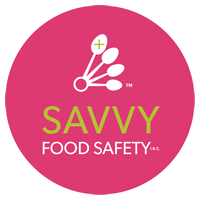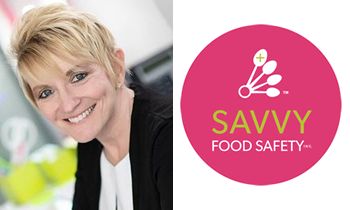
By Francine L. Shaw, President of Savvy Food Safety, Inc.
 The past few years have been incredibly difficult for everyone, but the food service industry has suffered like few other industries have. The National Restaurant Association (NRA) says nearly 90,000 food service establishments shuttered between the start of the pandemic and early 2021. Though it appears things may have begun to stabilize, there are some lingering effects.
The past few years have been incredibly difficult for everyone, but the food service industry has suffered like few other industries have. The National Restaurant Association (NRA) says nearly 90,000 food service establishments shuttered between the start of the pandemic and early 2021. Though it appears things may have begun to stabilize, there are some lingering effects.
Our country is suffering an unprecedented labor shortage, as 3.2M people have left the workforce since February 2020. During “The Great Resignation” (aka “The Great Reshuffle”) in late 2021, more than 47 million people quit their jobs. The leisure and hospitality industries are among the top sectors affected by labor force shortages, according to the U.S. Chamber of Commerce.
This workforce shortage has brought the food service industry to its knees. Fewer employees carry the burden of prepping, cooking, and serving food while keeping customers and businesses safe.
I went through a restaurant drive-thru a few months ago to get a cup of coffee, and they had the restaurant doors locked. The line at the drive-thru was literally wrapped around the building. I could hear the customers in the cars in front of me yelling at the cashier for being slow. I felt so bad for her that I wanted to park my car and go in to help – of course, that wasn’t an option. When I got to the window, she was in tears. I discovered she was the only person working in the front and back of the house. There was no management on the premise, just one very distraught employee! Honestly, I give her kudos for staying and trying to handle things by herself. However, I am confident she was too overwhelmed, exhausted, and overburdened to care about food safety. I’m not saying she would have intentionally neglected a responsibility, but she was so overworked and overwhelmed that it’s possible that she could have made an innocent mistake that could have caused a food safety breach.
Suppose someone had gotten a foodborne illness that day. The FDA Food Code recommends a PIC (Person-in-Charge) on every shift. In this scenario, she was the PIC – she was the only person working, making her the PIC by default. The PIC must have a food manager certification in this particular jurisdiction. What if she was a cashier who was working a part-time job on her high school summer break? It’s very possible that she didn’t have proper, formal food safety training, and yet she was in the PIC for that shift. Studies show that restaurants with kitchen managers certified in food safety are less likely to have foodborne illness outbreaks, and the CDC recommends that restaurants require kitchen manager food-safety certification from high-quality training programs. In this case, I’m not sure that this PIC was properly certified.
Foodborne illness is a widespread problem in our country. The CDC reports that 48 million Americans become sick, 128,000 are hospitalized, and 3,000 die from foodborne diseases yearly. Food safety breaches are expensive ($55.5 billion annually in the U.S. alone).
Investing in food safety training and education is one of the most brilliant things a food service establishment can do. Training and education are more critical than ever in the world we are living in today.
The FDA’s New Era of Smarter Food Safety, which represents a new approach to food safety, calls for businesses to leverage tech tools to create a safer food system. For instance, newly launched digital tools consolidate all certification data, making tracking this critical information easy, accurate, and convenient for each employee. Using software to simplify food safety and quality processes has been shown to cut 8 to 12 hours of labor per day per facility, and that is a significant cost (and time) saving.
As a food safety expert with 30+ years in the industry, I know firsthand that technology is elevating food safety protocols and is instrumental in reducing or eliminating food safety breaches. Now, tech tools can also help track and manage certifications, ensuring that all employees are current on critical food safety trainings. Technology enables operators to stay on top of training certifications and deadlines without monitoring cumbersome spreadsheets, a time-consuming and tedious process.
That’s why I helped develop TracSavvy, a must-have solution for food businesses, to reduce food safety risks and increase training compliance. TracSavvy, an affordable, user-friendly digital tool, will:
- Monitor training status to determine which employees are in compliance and which need refresher training or recertification.
- Automatically send reminders to operators and employees when refresher training or recertification training is due.
- Organize and consolidate all certification data, making tracking this critical information easy, accurate, and convenient.
- Stay up to date with food safety certifications for all employees and avoid the risks associated with expired food safety certifications.
- Provide a high ROI, saving your organization significant money in terms of fees, higher insurance premiums, reduced litigation, etc.
- Integrate seamlessly with other software that you use.
- Be a game-changer for restaurants/franchises and other food brands.
Designed by thought leaders in the food safety and technology space, TracSavvy is a cost-effective solution for an ongoing problem. There’s not another product like this on the market.
While it may seem unrealistic to invest in technology after a few years of major disruption, food brands can’t afford not to. Tech tools offer enormous ROI and can save restaurants significant money in terms of lost revenue, legal fees and litigation, negative press, and loss of customer loyalty if a food breach occurs. Today’s tech tools are affordable for restaurants of all sizes, and are more accessible, integrated, and user-friendly than ever before. As we all work to rebuild from a very difficult few years, tech tools can help us tremendously, keeping our foods, guests, employees, and businesses safer.
Francine L. Shaw is the CEO of Savvy Food Safety & TracSavvy, the co-founder of My Food Source, and a successful entrepreneur, author, and speaker. She spent 20+ years working in the foodservice industry. Her career has included performing services (operating partner, corporate/private trainer, health inspector, 3rd party inspector, adjunct professor) in various sectors of the foodservice industry, including academia, regulatory, private-sector, corporate America, creating digital software programs, and advising rising entrepreneurs. She has written 200+ articles for national trade magazines and appeared on Dr. Oz, the BBC World Series Radio, and iHeart Radio as a food safety expert.
